
foversta
[PuristSPro Moderator]
20814

Hands on review of the Lange & Söhne 1815 Rattrapante Honeygold
After last week's presentation of the 1815 Thin Honeygold, I would like to introduce you to the 1815 Rattrapante Honeygold, which is also one of the three watches celebrating the 175th anniversary of the opening of Ferdinand Adolf Lange's first workshop in Glashütte. I won't keep the suspense going for too long: the 1815 Rattrapante Honeygold is for me the most interesting piece of this trilogy. In fact, this watch is really good news. I remember that when the 1815 Rattrapante Perpetual Calendar was presented in 2013, I was one of those who regretted that the split-seconds chronograph, perhaps one of the most difficult watchmaking complications to master, was accompanied by an additional complication, the perpetual calendar.
Moreover, as all this was done in an "1815" context, the dates were not displayed by the double window "big date" display but by a small hand in a sub-dial. In other words, I thought it was a pity that the perpetual calendar was not very readable and therefore practical. I am convinced that Lange & Söhne should treat all its perpetual calendars with the big date display and this remark is also valid for the Tourbograph. In short, in spite of all its interest, I was more frustrated than seduced by the 1815 Rattrapante Perpetual Calendar which I found unnecessarily complicated (even if it remains of course, a great piece).
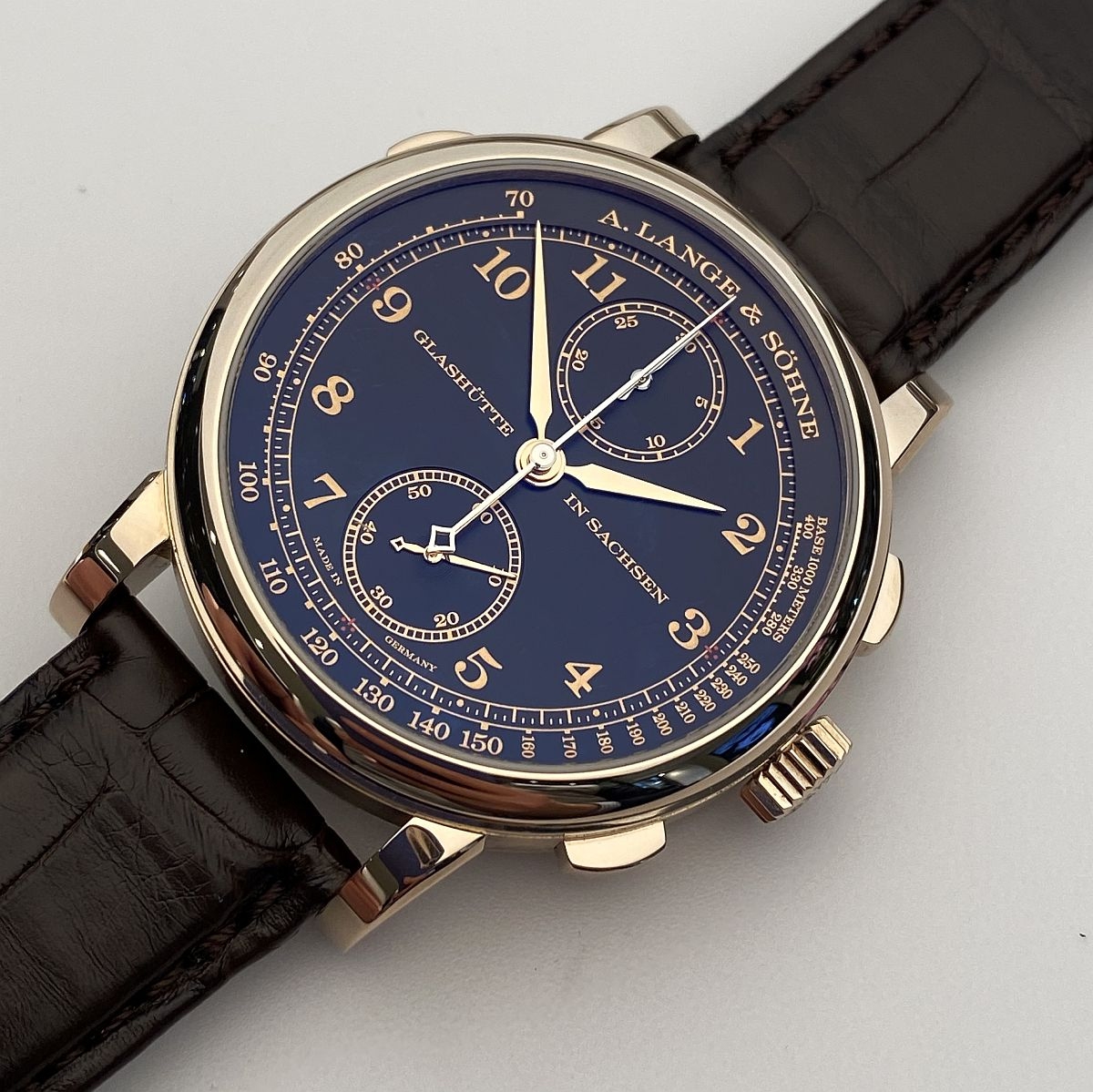
Eight years later, my wish is granted! Here comes the 1815 Rattrapante Honeygold which is a perpetual calendar-free version of the 1815 Rattrapante Perpetual Calendar. And it changes everything! First of all, the watch focuses on the major complication: the split-seconds chronograph. The first immediate impact is in the lay-out of the dial, which is much more airy. The two horizontally aligned sub-dials are removed (they were dedicated to the display of days and dates on the left, and to the display of months and years on the right). The watch now offers only two vertically aligned sub-dials, which makes it an originality in the world of Lange & Söhne chronographs. In addition, the moon-phase display in the lower sub-dial has also been removed, as this sub-dial is now only dedicated to the permanent second hand. A similar operation is performed in the upper sub-dial with the power reserve indicator removed. The minute counter always remains at the top of the dial and becomes much more legible. It is important to note at this point that there is only one hand dedicated to this minute counter since the split-second function works up to one minute apart. We are not in the case of a Double-Split and even less of a Triple-Split.
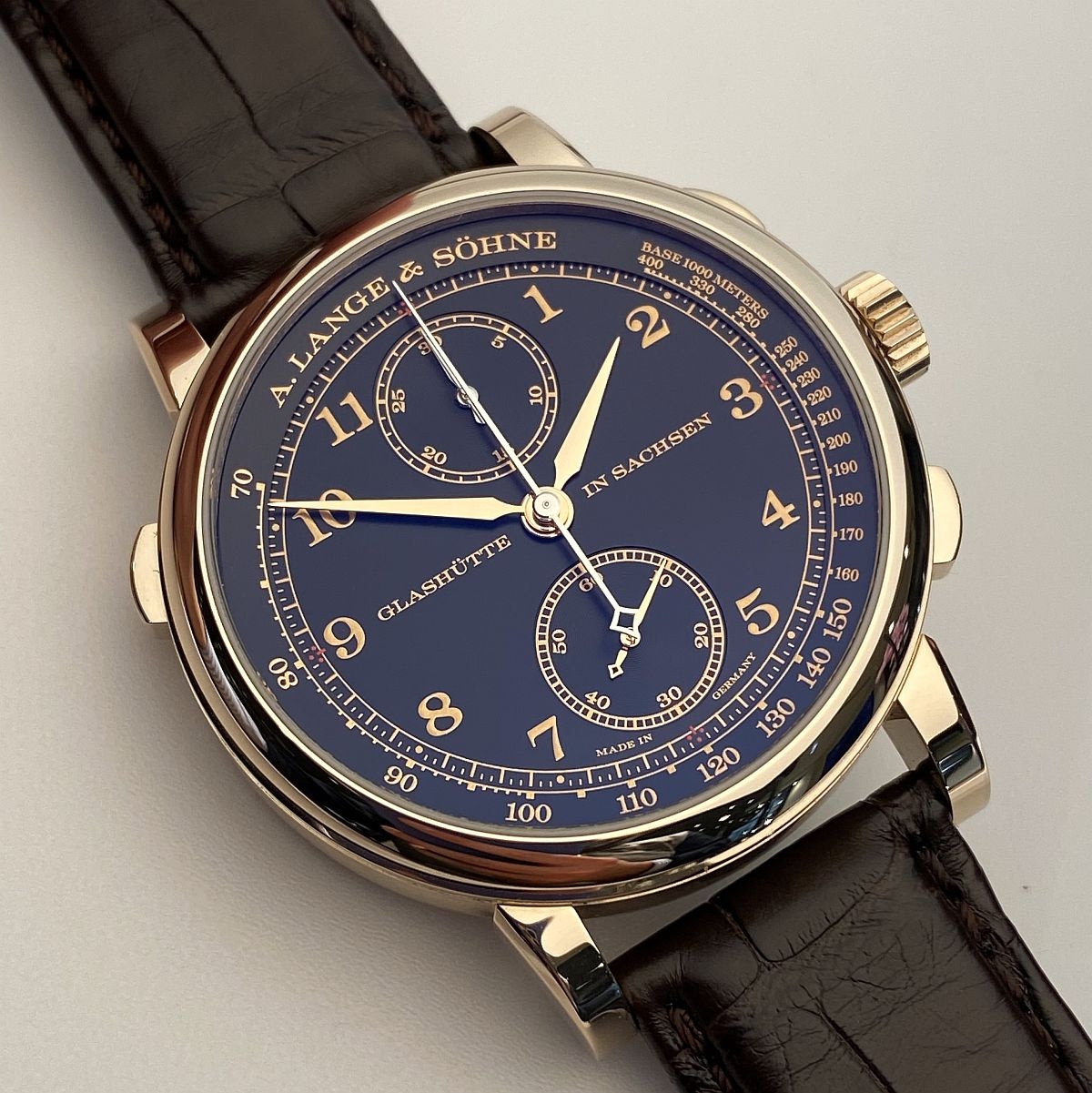
The withdrawal of the perpetual calendar is also perceptible on the case. Its diameter is slightly reduced (41.2mm vs 41.9mm for the 1815 Rattrapante Perpetual Calendar) but the most perceptible difference concerns the thickness. The height of the case is only 12.6mm compared to 14.7mm for the 1815 Rattrapante Perpetual Calendar and this is strongly felt when the watch is worn. In fact, the 1815 Rattrapante Honeygold appears slenderer and somehow more elegant.
Of course, this finesse is due to the height of the movement itself. The L101.2 caliber has a diameter of 32.6mm and a thickness of 7.4mm while the L101.1 caliber of the 1815 Rattrapante Perpetual Calendar has the same diameter but a thickness of 9.1mm. Due to the construction of the L101.1 movement where the perpetual calendar module is housed on the base movement (finally, the L101.2 caliber of the 1815 Rattrapante Honeygold), both watches offer similar views when turned over. Similar because of the architecture of the movements but different because of their decorations. This is one of the characteristics of the three watches paying tribute to Ferdinand Adolf Lange: their movements are decorated in a specific way. The L101.2 caliber is basically magnificent because of its presentation, its complexity, its organization even if it does not have the same depth effect as the Double-Split caliber. But in this context too, as with the 1815 Thin Honeygold, I particularly appreciate the grained finish of the bridges as well as the enhancement of the decoration of the balance wheel bridge and chronograph bridge thanks to the rhodium-plated black engravings. The chronograph bridge is also wide, which leaves more room for the floral engraving.
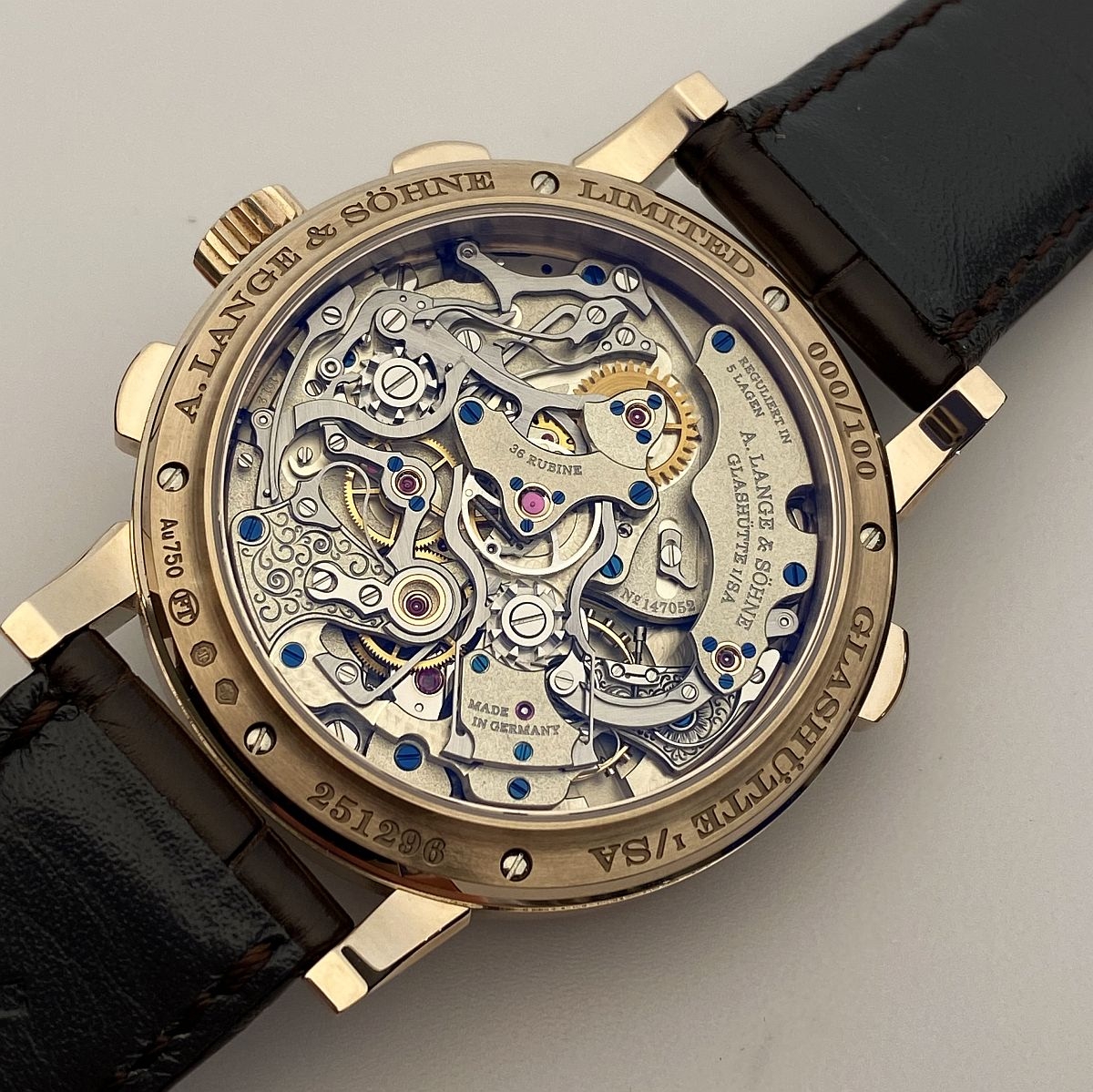
Considering the split-seconds chronograph, the caliber has two column wheels. All the additional mechanism really gives the feeling of watching a mechanical lace. The presentation of the movement and the fact that it generously occupies the case make it seductive and bewitching. I consider it to be the best of Saxon manufacture that expresses itself. The feelings when we use the pushers are perfect, neither too soft nor too hard, not to mention the sensation when we wind the movement. A chronograph caliber from Lange & Söhne is not only beautiful, it is also pleasant to use. The L101.2 caliber is no exception. Unsurprisingly, the frequency of the movement is 3hz (for a power reserve of 58 hours): this is the frequency of the manufacture's split-seconds chronographs, whereas "simple" chronographs have a frequency of 2.5hz.
The 1815 Rattrapante Honeygold is not only attractive on the movement side: it is also attractive on the dial side. Or more precisely, it is the combination between the dial and the case that makes all its charm. For once, Lange & Söhne chose a black dial to go with the honey gold case. The result is superb. The subtle reflections of the case give warmth to the dial. The contrast between black and gold is not aggressive, and the overall effect is one of refinement and harmony. In any case, I was very seduced by this aesthetic approach. The watch is readable, practical thanks to the performance of the movement and ultimately original in the context of the Saxon manufacture. The combination of colors and the vertical alignment of the sub-dials reinforce this singularity, even though the dial offers many of the usual details of the 1815 collection. Note that there are no cut-off numerals. The peripheral flange with a tachometric scale and the quality of finishing of the dial bring relief effects: the dial is not flat and it is ultimately as pleasant to observe as the movement.
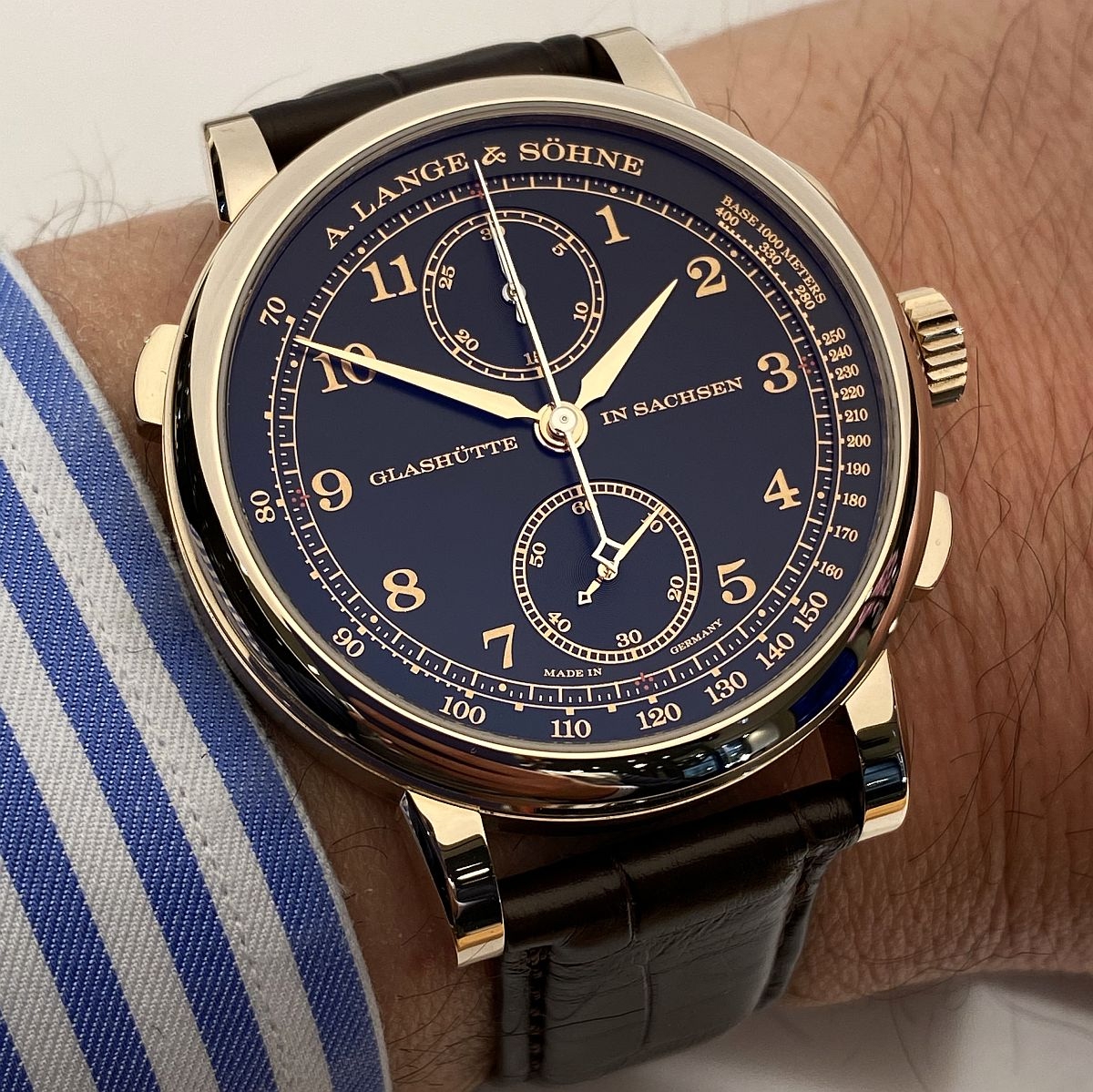
Once I put it on my wrist, I had no doubts. For me, the 1815 Rattrapante Honeygold supersedes the 1815 Rattrapante Perpetual Calendar. Finer, more elegant, warmer, focusing on the split-seconds chronograph complication, it represents the best of what the Saxon manufacture is capable of creating and producing. I didn't find any real flaw in it, and I even found it more attractive than the Tourbograph Perpetual Honeygold. The price is at this level of excellence, namely 131,100 euros including tax (in France), and this in the context of a limited series of 100 pieces. So even if the main complication is not as accomplished as that of a Double-Split (which remains the reference in the matter), the 1815 Rattrapante Honeygold is nonetheless a superb achievement by Lange & Söhne. In my opinion, it is one of the most beautiful novelties from them for at least 5 years. And I'm still wondering why the manufacturer didn't release this watch directly 8 years ago.
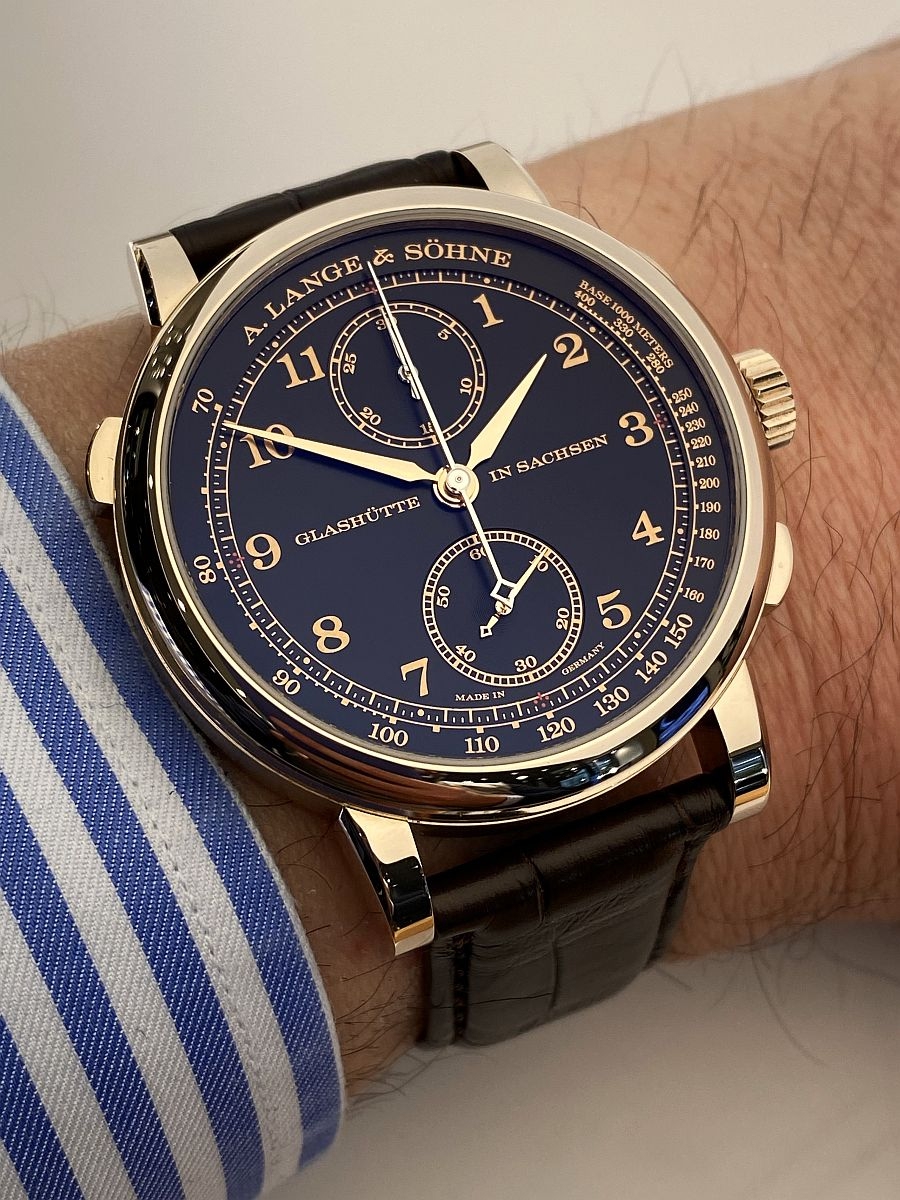
Pros:
+ an original dial presentation for a Lange & Söhne chronograph
+ the honey gold and black dial combination
+ the presentation and finishing of the movement
+ the performance of the movement, very pleasant to use
Cons:
- I didn't find any real negative point. The price is high but logical and above all much lower than that of the 1815 Rattrapante Perpetual. So, if I want to be nitpicking, I regret not to have the same performance in terms of split-seconds than with the Double-Split.
Fr.Xavier
More posts:

Hands on review of the Lange & Söhne 1815 Rattrapante Honeygold
After last week's presentation of the 1815 Thin Honeygold, I would like to introduce you to the 1815 Rattrapante Honeygold, which is also one of the three watches celebrating the 175th anniversary of the opening of Ferdinand Adolf Lange's first workshop i...

I didn't see this one coming. Excellent offer! In terms of proportions, beauty, elegance, classicism, it is a very good one! And Lange missed a " simple " Split Second, it is now done. Bravo.
Just one point I regret: The lack of choice between honey gold and another version in white metal ( gold or platinum ). Best, Nicolas


The more I see this watch, the more I love it!
Great review as always and no cons which is very rare! It may not be cheap but I think this gem of a watch strikes the right balance between a beautiful dial, a superbly finished movement and a reasonable price for a split second chronograph. The fact tha...

Great review and super photos as usual!
There are two things that I think are not up to Lange standards: 1) Sparse finishing on the bridges (no ribbing). 2) Incomplete and notchy hand engraving (see photo). John ...
The only 'con' (and this is being wishful) is...
...make it a 60-minute chrono. On the subject of big dates...turn the Saxonia Annual Calendar (with big date) into a perpetual and I will buy it tomorrow : ) I might buy it anyway...
I agree
the nicest langes in the past 5 yrs at least (with the exception of the Dato perpetual touby) - but i am biased towards chronos with 12-6 arrangement 2 nitpicking points : - 39-40mm would be perfection - the unsightly spring in the movement Ym
I wonder why..
I wonder if you know why they decided to use the spring.. rarely seen in high end split seconds chrono.. any idea?

Great review and photos 👍
Comparison shot I took last year at the London Boutique. ...

Fantastic 175th Anniversary pieces
Thank you FX for your review. I like the 175th anniversary watches very much, much better than the watch presented 5 years ago, where I wrote here: "And now the 1815 "200th Anniversary F.A. Lange"? A big watch with its 40 mm case, and "only" a black dial ...


Love it.
I want to see the honey gold in person. It looks so great in photos. Thanks for the thoughtful review.


